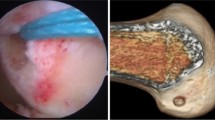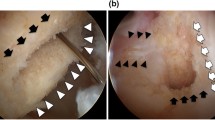Abstract
Purpose
Increasing demands on skills with mounting pressures from expectations from arthroscopic anterior cruciate ligament (ACL) reconstructions requires precise knowledge of technical details by surgeons. One such element is the minimum length of graft in femoral tunnel to allow for adequate tendon-to-bone healing and early return to activities and sports. This has, however, remained an unanswered question.
Purpose
To study and compare clinico-radiological outcomes of ACL reconstructions in patients with < 20 mm of intra-femoral tunnel graft length with those measuring ≥ 20 mm.
Methods
All eligible patients undergoing arthroscopic ACL reconstruction were sequentially divided into two groups based on the intra-femoral tunnel graft lengths (A: < 20 mm, n = 27; and B: ≥ 20 mm, n = 25). Exclusions were made for those > 45 years of age, with chondral and/or multi-ligamentous injuries and with systemic pathologies. All patients were postoperatively evaluated in clinics by physical examination and functional scoring (Lysholm and modified Cincinnati scores) at 3, 6 and 12-month intervals. Graft vascularity was assessed by signal-to-noise quotient ratio (SNQR) using magnetic resonance imaging (MRI) at 3 and 12 months.
Results
No significant differences were noted in mean Lysholm and modified Cincinnati scores between the two groups at the end of 1 year. There were also no significant differences in graft maturation over time and SNQR at 3 and 12 months in the region of interest (ROI).
Conclusions
Intra-femoral tunnel graft length of less than 20 mm does not compromise early clinical and functional outcomes of ACL reconstructions.







Similar content being viewed by others
Data availability
Yes.
Code availability
Custom.
References
Alentorn-Geli E, Samitier G, Álvarez P, Steinbacher G, Cugat R (2010) Anteromedial portal versus transtibial drilling techniques in ACL reconstruction: a blinded cross-sectional study at two- to five-year follow-up. Int Orthop 34:747–754. https://doi.org/10.1007/s00264-010-1000-1
Duquin T, Wind W, Fineberg M et al (2009) Current trends in anterior cruciate ligament reconstruction. J Knee Surg 22:7–12. https://doi.org/10.1055/s-0030-1247719
Morgan J, Dahm D, Levy B, Stuart M (2012) Femoral tunnel malposition in ACL revision reconstruction. J Knee Surg 25:361–368. https://doi.org/10.1055/s-0031-1299662
Harner C, Honkamp N, Ranawat A (2008) Anteromedial Portal Technique for Creating the Anterior Cruciate Ligament Femoral Tunnel. Arthroscopy 24:113–115. https://doi.org/10.1016/j.arthro.2007.07.019
Bedi A, Altchek D (2009) The “Footprint” anterior cruciate ligament technique: an anatomic approach to anterior cruciate ligament reconstruction. Arthroscopy 25:1128–1138. https://doi.org/10.1016/j.arthro.2009.03.008
Bedi A, Musahl V, Steuber V et al (2011) Transtibial versus anteromedial portal reaming in anterior cruciate ligament reconstruction: an anatomic and biomechanical evaluation of surgical technique. Arthroscopy 27:380–390. https://doi.org/10.1016/j.arthro.2010.07.018
Gavriilidis I, Motsis E, Pakos E et al (2008) Transtibial versus anteromedial portal of the femoral tunnel in ACL reconstruction: a cadaveric study. Knee 15:364–367. https://doi.org/10.1016/j.knee.2008.05.004
Hussein M, van Eck C, Cretnik A et al (2012) Individualized anterior cruciate ligament surgery. Am J Sports Med 40:1781–1788. https://doi.org/10.1177/0363546512446928
Zantop T, Ferretti M, Bell K et al (2008) Effect of tunnel-graft length on the biomechanics of anterior cruciate ligament-reconstructed knees. Am J Sports Med 36:2158–2166. https://doi.org/10.1177/0363546508320572
Cavaignac E, Marot V, Faruch M et al (2017) Hamstring graft incorporation according to the length of the graft inside tunnels. Am J Sports Med 46:348–356. https://doi.org/10.1177/0363546517733472
Richardson WS, Wilson MC, Nishikawa J, Hayward RS (1995) The well-built clinical question: a key to evidence-based decisions. ACP J Club 123(3):A12–A13
Yamazaki S, Yasuda K, Tomita F et al (2006) The effect of intraosseous graft length on tendon-bone healing in anterior cruciate ligament reconstruction using flexor tendon. Knee Surg Sports Traumatol Arthrosc 14:1086–1093. https://doi.org/10.1007/s00167-006-0110-1
Yuan F, Zhou W, Cai J et al (2013) Optimal graft length for anterior cruciate ligament reconstruction: a biomechanical study in beagles. Orthopedics 36:e588–e592. https://doi.org/10.3928/01477447-20130426-20
Mariscalco M, Magnussen R, Mitchell J et al (2014) How much hamstring graft needs to be in the femoral tunnel? A MOON cohort study. Eur Orthop Traumatol 6:9–13. https://doi.org/10.1007/s12570-014-0275-x
Guglielmetti L, Shimba L, do Santos L, et al (2017) The influence of femoral tunnel length on graft rupture after anterior cruciate ligament reconstruction. J Orthop Traumatol 18:243–250. https://doi.org/10.1007/s10195-017-0448-9
Weiler A, Peters G, Mäurer J et al (2001) Biomechanical properties and vascularity of an anterior cruciate ligament graft can be predicted by contrast-enhanced magnetic resonance imaging. Am J Sports Med 29:751–761. https://doi.org/10.1177/03635465010290061401
Tegner Y, Lysholm J (1985) Rating systems in the evaluation of knee ligament injuries. Clin Orthop Relat Res 198:43–49
Agel J, LaPrade R (2009) Assessment of Differences Between the Modified Cincinnati and International Knee Documentation Committee Patient Outcome Scores. Am J Sports Med 37:2151–2157. https://doi.org/10.1177/0363546509337698
Kulczycka P, Larbi A, Malghem J et al (2015) Imaging ACL reconstructions and their complications. Diag Interv Imaging 96:11–19. https://doi.org/10.1016/j.diii.2014.04.007
Grassi A, Bailey J, Signorelli C et al (2016) Magnetic resonance imaging after anterior cruciate ligament reconstruction: a practical guide. World J Orthop 7:638. https://doi.org/10.5312/wjo.v7.i10.638
Janssen R, Scheffler S (2013) Intra-articular remodelling of hamstring tendon grafts after anterior cruciate ligament reconstruction. Knee Surg Sports Traumatol Arthrosc 22:2102–2108. https://doi.org/10.1007/s00167-013-2634-5
Ntoulia A, Papadopoulou F, Ristanis S et al (2011) Revascularization process of the bone-patellar tendon–bone autograft evaluated by contrast-enhanced magnetic resonance imaging 6 and 12 months after anterior cruciate ligament reconstruction. Am J Sports Med 39:1478–1486. https://doi.org/10.1177/0363546511398039
Murakami Y, Sumen Y, Ochi M et al (1999) Appearance of anterior cruciate ligament autografts in their tibial bone tunnels on oblique axial MRI. Magn Reson Imaging 17:679–687. https://doi.org/10.1016/s0730-725x(99)00007-7
Li H, Tao H, Cho S et al (2012) Difference in graft maturity of the reconstructed anterior cruciate ligament 2 years postoperatively. Am J Sports Med 40:1519–1526. https://doi.org/10.1177/0363546512443050
White L, Kramer J, Recht M (2005) MR imaging evaluation of the postoperative knee: ligaments, menisci, and articular cartilage. Skeletal Radiol 34:431–452. https://doi.org/10.1007/s00256-005-0914-y
Li H, Chen J, Li H et al (2016) MRI-based ACL graft maturity does not predict clinical and functional outcomes during the first year after ACL reconstruction. Knee Surg Sports Traumatol Arthrosc 25:3171–3178. https://doi.org/10.1007/s00167-016-4252-5
Saupe N, White L, Chiavaras M et al (2008) Anterior cruciate ligament reconstruction grafts: MR imaging features at long-term follow-up—correlation with functional and clinical evaluation. Radiology 249:581–590. https://doi.org/10.1148/radiol.2492071651
Biercevicz A, Akelman M, Fadale P et al (2014) MRI volume and signal intensity of ACL graft predict clinical, functional, and patient-oriented outcome measures after ACL reconstruction. Am J Sports Med 43:693–699. https://doi.org/10.1177/0363546514561435
Colombet P, Graveleau N, Jambou S (2016) Incorporation of hamstring grafts within the tibial tunnel after anterior cruciate ligament reconstruction. Am J Sports Med 44:2838–2845. https://doi.org/10.1177/0363546516656181
Smith P, Stannard J, Pfeiffer F et al (2016) Suspensory versus interference screw fixation for arthroscopic anterior cruciate ligament reconstruction in a translational large-animal model. Arthroscopy 32:1086–1097. https://doi.org/10.1016/j.arthro.2015.11.026
Acknowledgements
No other contributors, no sources of funding, no assistance received
Funding
None received.
Author information
Authors and Affiliations
Corresponding author
Ethics declarations
Conflict of interest
Drs. Prateek Gupta, Ashis Acharya, Vishesh Khanna and Amit Mourya certify that they have no commercial associations that might pose a conflict of interest in connection with the submitted article.
Ethical approval.
Ethical review committee statement—included: Ethical Committee clearance obtained (vide clearance letter no. EC/09/15/896).
Consent to participate.
Informed consents were duly obtained from all eligible candidates.
Consent for publication.
Obtained.
Additional information
Publisher's Note
Springer Nature remains neutral with regard to jurisdictional claims in published maps and institutional affiliations.
Rights and permissions
About this article
Cite this article
Gupta, P.K., Acharya, A., Khanna, V. et al. Intra-femoral tunnel graft lengths less than 20 mm do not predispose to early graft failure, inferior outcomes or poor function. A prospective clinico-radiological comparative study. Musculoskelet Surg 107, 179–186 (2023). https://doi.org/10.1007/s12306-022-00740-3
Received:
Accepted:
Published:
Issue Date:
DOI: https://doi.org/10.1007/s12306-022-00740-3




